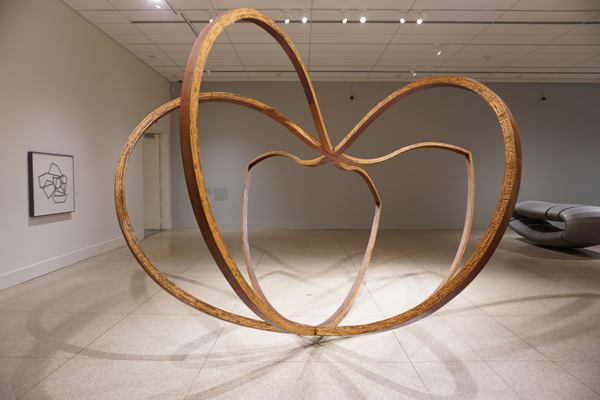Forty-three works in an expansive range of media highlight Richard Deacon’s versatility in a broad yet uneven survey of the British sculptor’s art from 1979–2016 in “What You See Is What You Get” at The San Diego Museum of Art.
Deacon’s austerely lyrical configurations often seem vaguely referential to various real-world forms both factitious and organic. Under the Weather No. 1 (2016) evokes a coppice while also resembling two elongated chandeliers fused together. Though created without this show in mind, this piece appears to have always belonged at the exhibition’s entrance among electroliers and ornate doorway moldings.
Many sculptures exude a practical ambience like furniture or architecture; utile-looking accouterments make them seem like mysterious devices meant to serve unknown purposes. For example, shelf and curtain-like appurtenances give Falling on Deaf Ears No. 1 (1984) a utilitarian effect. Yet paradoxically, structural superfluities symbolize functionlessness. Fabrication is consistently emphasized in visible joints, glue bubbles and screws, most of these structurally unnecessary embellishments, the sculptural equivalent of phony dresser drawers or faux shoe buckles.

Richard Deacon, Housing 10, 2012, L.A. Louver, Venice, CA.
His most impressive sculptures are large-scale, dominating their surroundings and transforming viewers’ spatial perception. Among them, Like a Bird (1984) connotes its titular animal as well as rocking chairs and upholstery shops; Distance No Object (1988) resembles a subterranean tunnel, water conduit, or skate park pipe; and Nothing is Allowed (1994) loosely suggests conveyor belts, inner tubes, and upholstered seats. Each of these emanates a singular presence with a plethora of evocations.
Metal and wood are Deacon’s fortes. Splashy ceramic pieces are relatively ineffective, seemingly decorative pastiches of other sculpture. Moreover, in Deacon’s hands, clay doesn’t lend itself to showing the process behind its creation. In contrast with his large sculptures’ commanding presence and multifarious connotations, most of his smaller pieces lack intricacy and nuance regardless of their medium. Though diminutive, they seem far less deserving of the space they occupy.
Overall, the exhibition is visually felicitous. Views of multiple sculptures are dynamically interwoven, while subtle similarities of form echo sonorously among different pieces. However, some presentational aspects are lacking. Although the time period spans over three decades, certain years are clustered; the choice of works for this exhibition was limited to collections held domestically. A preponderance of works from 1984–88, 2000, 2007 and 2012 leads one to wonder what else Deacon was producing in between, and how one body of work led to another, a curiosity compounded by the absence of didactic wall labels.
Information might easily have filled gaps; but curators honored the artist’s disinclination toward the customary didactics and instead offered information only via smartphone app. The decision to keep the space around the artworks “clean” in this manner is self-defeating; using a phone fundamentally alters one’s experience of the objects. This being Deacon’s first United States museum survey, the dearth of easily accessible explanatory information seems particularly regrettable. What you see may be what you get, but background and context can help you comprehend what you’re getting. Notwithstanding, Deacon’s sculptures speak eloquently for themselves; and this show does present enough fine examples to enable one to understand a substantial cross-section of his practice


